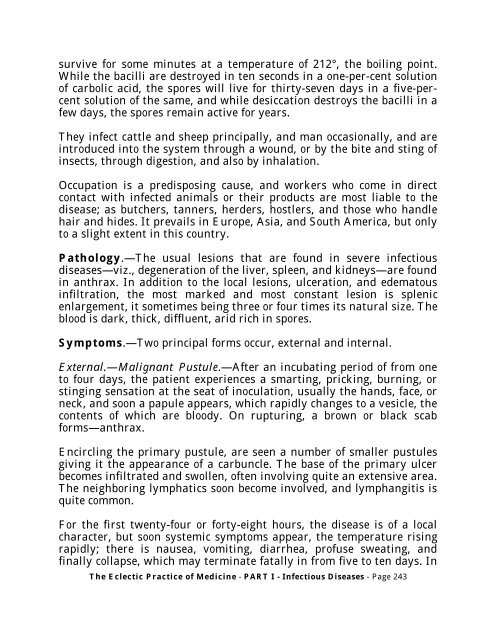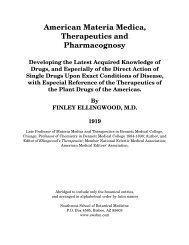SCARLET FEVER. Synonyms.—Scarlatina; Scarlet Rash. Definition ...
SCARLET FEVER. Synonyms.—Scarlatina; Scarlet Rash. Definition ...
SCARLET FEVER. Synonyms.—Scarlatina; Scarlet Rash. Definition ...
You also want an ePaper? Increase the reach of your titles
YUMPU automatically turns print PDFs into web optimized ePapers that Google loves.
survive for some minutes at a temperature of 212°, the boiling point.<br />
While the bacilli are destroyed in ten seconds in a one-per-cent solution<br />
of carbolic acid, the spores will live for thirty-seven days in a five-percent<br />
solution of the same, and while desiccation destroys the bacilli in a<br />
few days, the spores remain active for years.<br />
They infect cattle and sheep principally, and man occasionally, and are<br />
introduced into the system through a wound, or by the bite and sting of<br />
insects, through digestion, and also by inhalation.<br />
Occupation is a predisposing cause, and workers who come in direct<br />
contact with infected animals or their products are most liable to the<br />
disease; as butchers, tanners, herders, hostlers, and those who handle<br />
hair and hides. It prevails in Europe, Asia, and South America, but only<br />
to a slight extent in this country.<br />
Pathology.—The usual lesions that are found in severe infectious<br />
diseases—viz., degeneration of the liver, spleen, and kidneys—are found<br />
in anthrax. In addition to the local lesions, ulceration, and edematous<br />
infiltration, the most marked and most constant lesion is splenic<br />
enlargement, it sometimes being three or four times its natural size. The<br />
blood is dark, thick, diffluent, arid rich in spores.<br />
Symptoms.—Two principal forms occur, external and internal.<br />
External.—Malignant Pustule.—After an incubating period of from one<br />
to four days, the patient experiences a smarting, pricking, burning, or<br />
stinging sensation at the seat of inoculation, usually the hands, face, or<br />
neck, and soon a papule appears, which rapidly changes to a vesicle, the<br />
contents of which are bloody. On rupturing, a brown or black scab<br />
forms—anthrax.<br />
Encircling the primary pustule, are seen a number of smaller pustules<br />
giving it the appearance of a carbuncle. The base of the primary ulcer<br />
becomes infiltrated and swollen, often involving quite an extensive area.<br />
The neighboring lymphatics soon become involved, and lymphangitis is<br />
quite common.<br />
For the first twenty-four or forty-eight hours, the disease is of a local<br />
character, but soon systemic symptoms appear, the temperature rising<br />
rapidly; there is nausea, vomiting, diarrhea, profuse sweating, and<br />
finally collapse, which may terminate fatally in from five to ten days. In<br />
The Eclectic Practice of Medicine - PART I - Infectious Diseases - Page 243

















